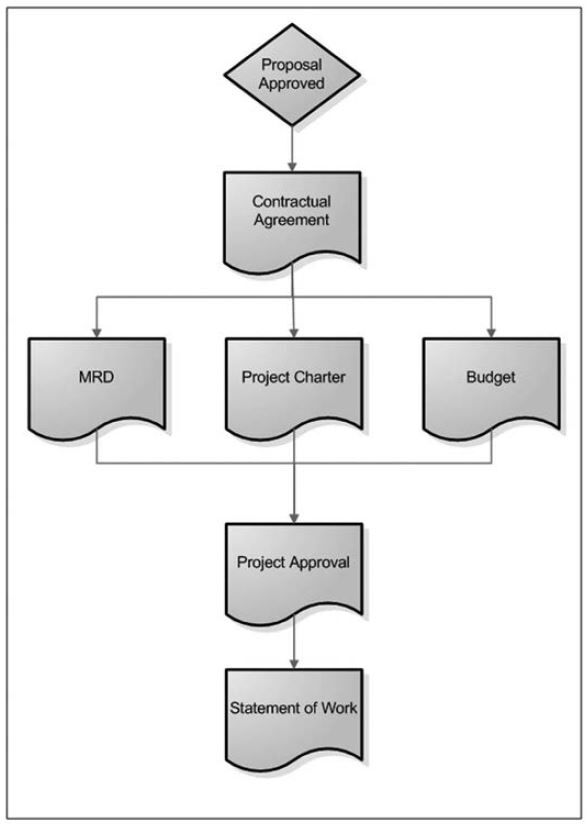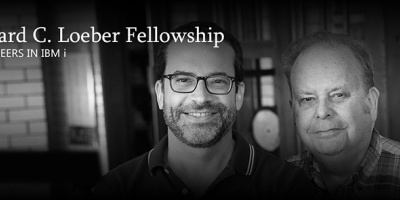The Project Proposal has been approved. What next? The project must now be defined in greater detail.
Editor's Note: This article is excerpted from chapter 4 of Fundamentals of Technology Project Management, by Colleen Garton and Erika McCulloch.
The project definition includes the creation of:
- The Project Charter
- The Marketing Requirements Document (MRD)
- The Budget
- The Statement of Work (SOW)
The flowchart in Figure 4.1 shows the project definition workflow process from the proposal being approved through to project approval.
If the project is for an external client, a contractual agreement is usually drawn up between the two parties. The reason for this agreement is that in the event that the project is cancelled after the definition documents are complete, the vendor can charge the client for the time spent working on them. This can amount to a substantial amount of work for quite a few members of the proposed project team. The contractual agreement offers a level of protection to the development company by ensuring monetary compensation for time spent as well as dissuading the client from working with multiple vendors on the definition of the project at the same time. If they are not charged for the time, then they have nothing to lose by wasting the vendors’ time on projects that they have little, or no, intention of awarding them.
Figure 4.1: Project Definition Flowchart
Project Charter
Subsequent to the approval of a Project Proposal, a client meeting will be held to create a Project Charter Document. A Project Charter is also referred to as a Project Brief. A client may be an external client, where your company is being contracted to develop the product or service for them. Alternatively, the client may be an internal customer, for instance where a technology company is developing a new product for its own product line. The key people involved in the project are defined in the Project Charter. The Project Charter is a “must have” for all projects no matter how large or small. This document is the basis on which successful project plans are built. It provides specific agreements, including budgets and schedules, to which all team members will commit. It is used as a major input to the detailed resource and development plans that are created as each phase of the lifecycle is planned (planning, design, development, integration, deployment, and post-deployment).
The Project Charter Document will be used in conjunction with the Marketing Requirements Document as the foundation for creating the initial technical requirements documents for the product. The lack of a Project Charter Document can lead to poor communication, misunderstanding, and potential confusion. The failure to have a formalized plan can put the project at high risk. Everyone involved in the project needs to have clear and specific goals outlined before the project is kicked off. The whole team needs to understand the “big picture” as well as the specifics for their individual contributions.
The clear and accurate definition of a project and its objectives is extremely important to a project’s success. Defining the project, specifying the scope, and developing a common vision of the project objectives and deliverables are synonymous with effective planning.
Producing a quality Project Charter Document requires following specific steps and a lot of attention to detail. The amount of detail necessary for the Project Charter
Document will depend on the size and complexity of the project. The document must include specifically what will and will not be delivered. Before starting work on the Project Charter, it is imperative that you have written approval from the client (who can be an external company or an internal department or group). After all, they will be billed for the time, so they need to agree to pay for it!
The Project Charter comprises the following sections:
- Project Name
- Client Name
- Decision Makers
- Project Description and Goals
- Business Case
- Key Business Requirements
- Project Objectives
- Benefits
- Target Audience
- The Problem
- The Solution
- Project Scope
- Prerequisites
- Assumptions
- Project Constraints
- Project Risks
- Time and Costs
- Project Organization
- Project Charter Approval
It is the project manager’s responsibility to create the Project Charter Document. In this chapter, I will lead you through each section of the Project Charter Document and give you the information and the tools you need to both understand and create it!
Next time we will discuss: Creating the Project Charter Documents.
Want to learn more about project management best practices now? Pick up your own copy of Fundamentals of Technology Project Management, by Colleen Garton and Erika McCulloch - available and on sale at the MC Press Bookstore today!


























 More than ever, there is a demand for IT to deliver innovation. Your IBM i has been an essential part of your business operations for years. However, your organization may struggle to maintain the current system and implement new projects. The thousands of customers we've worked with and surveyed state that expectations regarding the digital footprint and vision of the company are not aligned with the current IT environment.
More than ever, there is a demand for IT to deliver innovation. Your IBM i has been an essential part of your business operations for years. However, your organization may struggle to maintain the current system and implement new projects. The thousands of customers we've worked with and surveyed state that expectations regarding the digital footprint and vision of the company are not aligned with the current IT environment. TRY the one package that solves all your document design and printing challenges on all your platforms. Produce bar code labels, electronic forms, ad hoc reports, and RFID tags – without programming! MarkMagic is the only document design and print solution that combines report writing, WYSIWYG label and forms design, and conditional printing in one integrated product. Make sure your data survives when catastrophe hits. Request your trial now! Request Now.
TRY the one package that solves all your document design and printing challenges on all your platforms. Produce bar code labels, electronic forms, ad hoc reports, and RFID tags – without programming! MarkMagic is the only document design and print solution that combines report writing, WYSIWYG label and forms design, and conditional printing in one integrated product. Make sure your data survives when catastrophe hits. Request your trial now! Request Now. Forms of ransomware has been around for over 30 years, and with more and more organizations suffering attacks each year, it continues to endure. What has made ransomware such a durable threat and what is the best way to combat it? In order to prevent ransomware, organizations must first understand how it works.
Forms of ransomware has been around for over 30 years, and with more and more organizations suffering attacks each year, it continues to endure. What has made ransomware such a durable threat and what is the best way to combat it? In order to prevent ransomware, organizations must first understand how it works. Disaster protection is vital to every business. Yet, it often consists of patched together procedures that are prone to error. From automatic backups to data encryption to media management, Robot automates the routine (yet often complex) tasks of iSeries backup and recovery, saving you time and money and making the process safer and more reliable. Automate your backups with the Robot Backup and Recovery Solution. Key features include:
Disaster protection is vital to every business. Yet, it often consists of patched together procedures that are prone to error. From automatic backups to data encryption to media management, Robot automates the routine (yet often complex) tasks of iSeries backup and recovery, saving you time and money and making the process safer and more reliable. Automate your backups with the Robot Backup and Recovery Solution. Key features include: Business users want new applications now. Market and regulatory pressures require faster application updates and delivery into production. Your IBM i developers may be approaching retirement, and you see no sure way to fill their positions with experienced developers. In addition, you may be caught between maintaining your existing applications and the uncertainty of moving to something new.
Business users want new applications now. Market and regulatory pressures require faster application updates and delivery into production. Your IBM i developers may be approaching retirement, and you see no sure way to fill their positions with experienced developers. In addition, you may be caught between maintaining your existing applications and the uncertainty of moving to something new. IT managers hoping to find new IBM i talent are discovering that the pool of experienced RPG programmers and operators or administrators with intimate knowledge of the operating system and the applications that run on it is small. This begs the question: How will you manage the platform that supports such a big part of your business? This guide offers strategies and software suggestions to help you plan IT staffing and resources and smooth the transition after your AS/400 talent retires. Read on to learn:
IT managers hoping to find new IBM i talent are discovering that the pool of experienced RPG programmers and operators or administrators with intimate knowledge of the operating system and the applications that run on it is small. This begs the question: How will you manage the platform that supports such a big part of your business? This guide offers strategies and software suggestions to help you plan IT staffing and resources and smooth the transition after your AS/400 talent retires. Read on to learn:
LATEST COMMENTS
MC Press Online